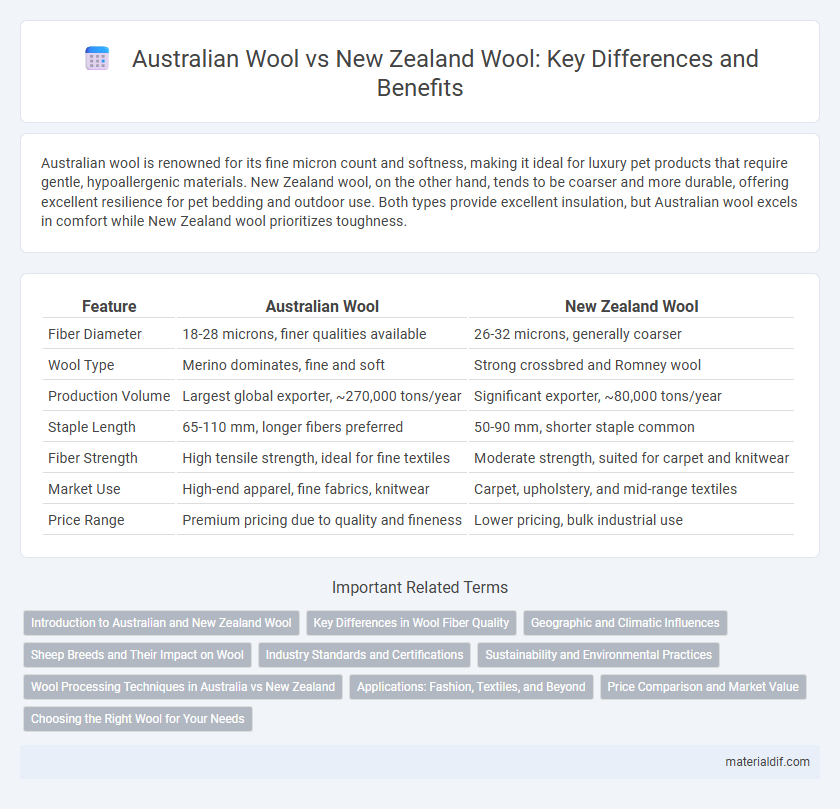Australian wool is renowned for its fine micron count and softness, making it ideal for luxury pet products that require gentle, hypoallergenic materials. New Zealand wool, on the other hand, tends to be coarser and more durable, offering excellent resilience for pet bedding and outdoor use. Both types provide excellent insulation, but Australian wool excels in comfort while New Zealand wool prioritizes toughness.
Table of Comparison
| Feature | Australian Wool | New Zealand Wool |
|---|---|---|
| Fiber Diameter | 18-28 microns, finer qualities available | 26-32 microns, generally coarser |
| Wool Type | Merino dominates, fine and soft | Strong crossbred and Romney wool |
| Production Volume | Largest global exporter, ~270,000 tons/year | Significant exporter, ~80,000 tons/year |
| Staple Length | 65-110 mm, longer fibers preferred | 50-90 mm, shorter staple common |
| Fiber Strength | High tensile strength, ideal for fine textiles | Moderate strength, suited for carpet and knitwear |
| Market Use | High-end apparel, fine fabrics, knitwear | Carpet, upholstery, and mid-range textiles |
| Price Range | Premium pricing due to quality and fineness | Lower pricing, bulk industrial use |
Introduction to Australian and New Zealand Wool
Australian wool, known for its fine Merino fibers, dominates the global wool market with a reputation for high quality and versatility in textiles. New Zealand wool, often coarser and primarily sourced from Romney and other dual-purpose breeds, excels in durability and is widely used in carpets and upholstery. Both countries are leading exporters, with Australia supplying the majority of superfine wool and New Zealand specializing in medium to strong wool varieties.
Key Differences in Wool Fiber Quality
Australian wool is renowned for its fine micron count, typically ranging from 18 to 24 microns, making it highly desirable for lightweight and soft clothing applications. New Zealand wool generally features coarser fibers, averaging between 25 to 35 microns, which enhances its durability and suitability for carpets and upholstery. The crimp frequency and staple length also differ, with Australian wool exhibiting higher crimp and longer staples, contributing to its superior elasticity and processing performance.
Geographic and Climatic Influences
Australian wool typically benefits from the country's vast and varied climate zones, with extensive arid and semi-arid regions promoting the growth of fine Merino fibers prized worldwide for their softness and durability. New Zealand wool, predominantly produced in temperate and humid coastal regions, tends to have a higher yield of medium to strong fiber types, reflecting the lush pastures and consistent rainfall that influence sheep grazing patterns. Geographic and climatic distinctions between Australia and New Zealand directly impact fleece characteristics, fiber diameter, and overall wool quality, shaping the market preferences for each nation's wool products.
Sheep Breeds and Their Impact on Wool
Australian wool primarily comes from Merino sheep, known for producing fine, soft fibers with excellent crimp and elasticity, ideal for high-quality textiles. New Zealand wool is often sourced from Romney and Corriedale breeds, which yield coarser yet durable wool suited for rugs and outerwear. The breed differences significantly influence fiber diameter, staple length, and wool strength, driving diverse market applications.
Industry Standards and Certifications
Australian wool is primarily certified under the Responsible Wool Standard (RWS), ensuring sustainable practices and animal welfare, while New Zealand wool often aligns with the ZQ Merino certification, emphasizing high environmental and ethical standards. Both countries adhere to stringent industry standards such as the Woolmark certification, reflecting quality and performance benchmarks recognized globally. The certifications highlight Australia's focus on large-scale, traceable farm systems and New Zealand's emphasis on pristine, sustainable pastoral environments.
Sustainability and Environmental Practices
Australian wool is renowned for its strict sustainability standards, emphasizing responsible grazing practices and water conservation to minimize environmental impact. New Zealand wool also prioritizes eco-friendly production, with a strong focus on animal welfare and pasture management to enhance soil health and biodiversity. Both countries lead in sustainable wool production, yet Australia's larger scale fosters advanced innovations in carbon footprint reduction and renewable energy use on farms.
Wool Processing Techniques in Australia vs New Zealand
Australian wool processing emphasizes advanced mechanical scouring and lanolin recovery methods to maintain fiber quality and environmental standards. New Zealand employs a combination of traditional washing techniques and innovative enzyme treatments that enhance fiber softness and durability. Both countries integrate cutting-edge technology, but Australia's process often leads in automation, whereas New Zealand focuses on eco-friendly, sustainable practices in wool scouring.
Applications: Fashion, Textiles, and Beyond
Australian wool, prized for its fine Merino fibers, dominates high-end fashion and luxury textiles due to its superior softness, durability, and breathability. New Zealand wool, often coarser and stronger, excels in rugged outdoor apparel, upholstery, and industrial textiles where resilience and insulation are critical. Both types cater to diverse markets, with Australian wool preferred for premium garments and New Zealand wool widely used in technical textiles and composite materials.
Price Comparison and Market Value
Australian wool generally commands higher prices in the global market due to its superior fiber length and strength, making it highly sought after for fine textiles and apparel. New Zealand wool, while less expensive, is valued for its versatility and is widely used in carpet manufacturing and bulk textiles, influencing its more competitive pricing. Market value differences are also impacted by supply volume, with Australia producing significantly more wool annually, enhancing its influence on price stability and demand.
Choosing the Right Wool for Your Needs
Australian wool is renowned for its fine micron count and softness, making it ideal for high-quality garments and next-to-skin wear. New Zealand wool, often coarser but highly durable, suits outerwear and heavy-duty textiles that require excellent resilience. Selecting the right wool depends on the desired fabric texture, strength, and application, with Australian wool excelling in luxury apparel and New Zealand wool preferred for robust, long-lasting products.
Australian Wool vs New Zealand Wool Infographic

 materialdif.com
materialdif.com